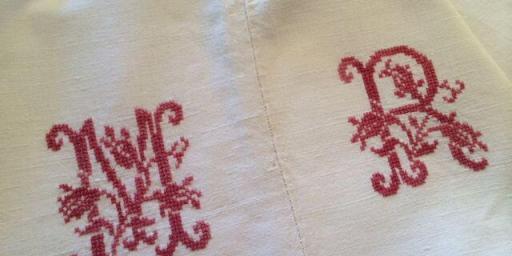The Fabric of our Lives in Provence
I’ve always loved fabrics, their feel, the patterns of their weave or printed design, the richness of their colours, as well as their potential for being transformed into the functional or the beautiful, the mundane or the luxurious. They also have a rich and fascinating history. Stone loom weights, used to keep warp threads taut, have been found dating back to the Neolithic era, proof that people were already spinning and weaving fibres into cloth; certainly, textiles have played an essential role in our social, cultural and economic development. There’s also something about their innate fragility, their susceptibility to deterioration through humidity, light, insects, as well as everyday wear and tear, which makes their existence over time more special: fragments of ancient textiles have a very particular beauty and virtue.
From first experiments in making clothes for myself in my teens, to making them for my children when they were young, from running up curtains, chair and cushion covers for my first home (and perhaps too many house moves since!) to carefully piecing together patchwork quilts, the enjoyment that came in their creation was in part the knowledge that this is a time-honoured occupation: traditionally women’s work since the beginning of civilisation. It had been a long-held dream of mine to start a small business, and something creative to do with textiles became an obvious choice as I planned a career change. A move to France brought a new perspective and I was delighted to learn that our new home included a former magnanerie (silk-farm), one which no doubt supplied raw, silk cocoons to one of the several silk mills existing in Uzès a century ago.
Back in the UK, I had also enjoyed collecting household linens, vintage embroidered pieces adding to the family hoard: now in France, I extended my collection into the heavy, homespun linen and hemp sheets woven years ago in farmhouses such as mine on narrow, domestic looms and neatly sewn together along their length with tiny stitches; other, finer linen sheets, embroidered with impressive monograms and embellished with heavy lace, no doubt made by skilled and hopeful girls to keep as part of a trousseau, would have been very much in place in a respectable maison-de-maître, or even in a château: one can only imagine the stories they could tell.
But nor have I rejected those household linens pulled from an untidy pile on market stalls and at vide-greniers: sheets which have been carefully patched, sometimes over-sewn with a reinforcing piece of fabric in the middle and much-laundered in the village lavoir: they, too, have their history. I think of the women, large bundles on their shoulders or pulling their carts of washing down to the village washing-place to gossip while scrubbing the household linens before placing them on hedges to dry in the southern sun. I’m grateful to be living in a time and place where I do not to have to do that myself but enjoy recycling the wonderfully time-worn and softened fabric into such items as cushion covers and pillow bolsters.
Any study of the history of textiles is not, of course, without its political side. As historians and economists know, this has always been the case. The recent protest against clothing made in sweatshops, the associated human rights issues, as well as damage done to the environment by some aspects of the industry, have recently led to several movements promoting a more ethical and less wasteful attitude towards the making of our clothes. Designers such as the indomitable Vivienne Westwood, with her ‘buy-better-buy-less’ philosophy, as well as the Twitter campaign #whomademyclothes are having some impact on an industry which has recently been responsible for mass production without any responsibility for working conditions in factories nor the resulting vast tonnage of “disposable fashion” filling our landfill sites. Fair Trade standards and organic textile production are also having some impact in creating customer awareness.
This is all having an effect on the industry: I am now one of an internet-enabled and rapidly-growing number of small producers of individually-made and limited runs of items, serving those discerning consumers who want to wear good fashion with a conscience. My ‘Amorgina’ range of clothing for women (available online and from my atelier by appointment) draws on the tradition of using fine, natural fabrics in silk and linen from reputable producers and suppliers, then made here in France into modern yet classic designs – a 21st century take on a home industry which has evolved over millennia.




No Comment